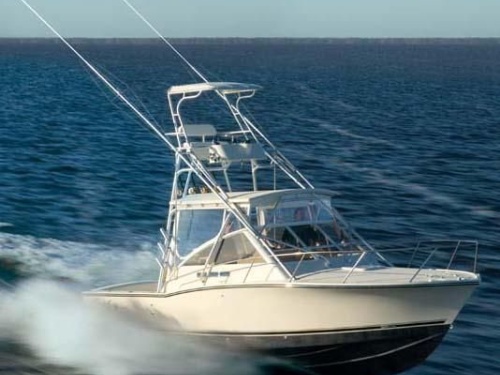Access More Boat Tests
Already have an account? Login
Carolina Classic 25 (2014-)
Brief Summary
For years the Carolina Classic 25 was one of the smallest and most rugged fishing boats on the market with either gas or diesel power. Now she is available with twin Yamaha outboard engines and all of a sudden she seems to be even more desirable than before. With more usable cockpit space and greater speed, this deep-V classic is right at home 100 miles off the Carolina coast.
Key Features
- Hardtop with electronics box, weather enclosures and rocket launcher
- Fiberglass swim platform
- 2 bilge pumps with indicator lights
- Live bait well
- 4 rod holders
- Tackle cabinets
- Helm and companion chair
- Electric head
- V-berth lounge with cushions and storage
Specifications
| Length Overall | 25' 2'' / 7.67 m |
|---|---|
| Beam |
8' 6'' 2.59 m |
| Dry Weight |
7,000 lbs. 3.18 kg |
| Draft |
30'' 0.76 m |
| Deadrise/Transom | 24-deg. |
| Max Headroom | open |
| Bridge Clearance | N/A |
| Fuel Capacity |
165 gal. 625 L |
| Water Capacity |
23 gal. 87 L |
Engine Options
| Tested Engine |
Currently no test numbers |
|---|---|
| Std. Power |
Not Available |
| Opt. Power |
1 x 375-hp Crusader Captain's Choice 6.0 MPI 1 x 300-hp Volvo Penta D4-300 1 x 315-hp Yanmar 6LP-STP2 1 x 370-hp Yanmar 6LYA-STP Three Yamaha outboard engine options from 225 to 300-hp |
Captain's Report
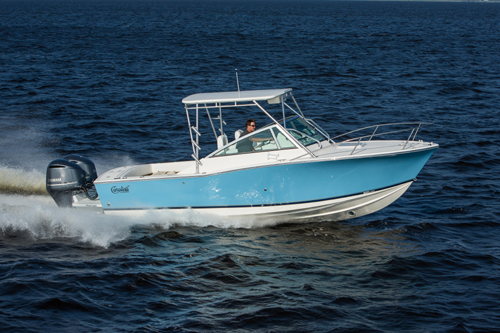
Mission of the Carolina Classic 25
Whether fishing off the Outer Banks of North Carolina, or the canyons farther north, or oil platforms far into the Gulf of Mexico, trips far offshore are the domain of 35-foot plus sportfishers, right? Well, no. This Carolina Classic 25 was designed to catch the fantastic year-round fishing opportunities off Cape Hatteras, while also handling the notoriously quick-changing and often nasty weather that comes with fishing those waters.
With her deep-V solid fiberglass hull and 43-square-foot cockpit, the Carolina Classic 25 has been fishing far offshore alongside much bigger boats since 1991. Based at first on a customer request -- a CC25 inboard owner needed a shallow draft -- Carolina Classic recently began offering the boat with outboard power. This latest version will get to the fish fast and back home safe when the weather kicks up. The Armstrong bracket preserves the full transom height for safety and leaves the big-boat style fishing cockpit unaltered.
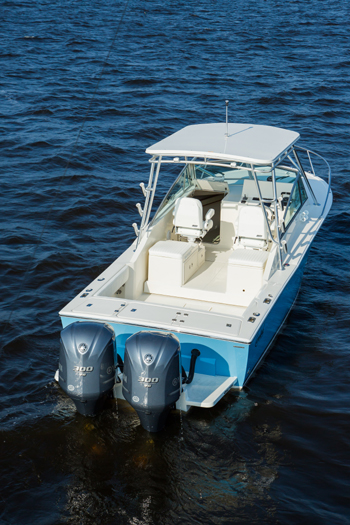
Outboards and Armstrong Bracket
Rather than building a traditional notched transom to make room for outboards, Carolina Classic chose to hang twin Yamaha outboards on an aluminum Armstrong bracket. This moves engine weight aft, improving the ride at high speed. Propellers farther back, biting into clean water, also tend to increase top speed and fuel efficiency over transom-mounted outboards. The bracket also adds buoyancy -- about equivalent to the weight of one of the outboards -- to balance the boat on her waterline at the dock. With the 215-gallon fuel tank forward, directly above the boat’s center of gravity, she sits evenly on that waterline whether full of fuel or empty.
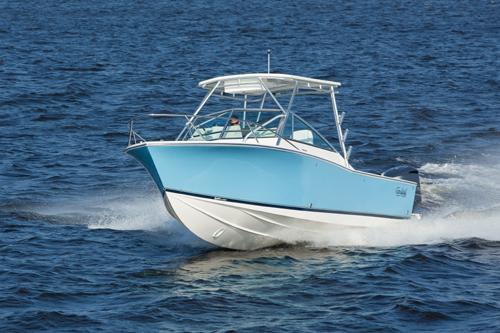
Trailerable
With just 8'6" (2.59 m) of beam and outboard power, the Carolina Classic 25 on a trailer can travel all over North America without over-road width restrictions. Try that with triple- or quad-outboard behemoths (and compare your total fuel bill against theirs at the end of the trip). At 7,000 lbs. (3,175 kgs.) dry weight, a substantial tow vehicle will be needed, but the solid fiberglass hull will be more than welcome offshore.
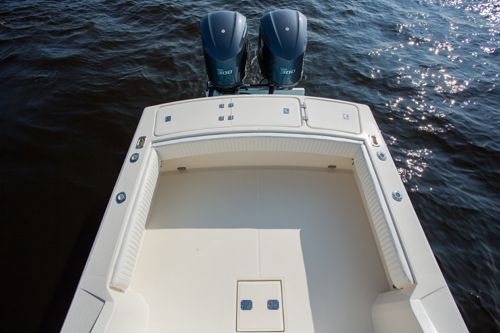
Battlewagon Fishability from a Small Boat
For an offshore fishing boat, perhaps the biggest benefit of the Armstrong bracket is the uncluttered stern. Whether adjusting the trolling spread or fishing live bait, the Carolina Classic 25 cockpit feels like a bigger, inboard-powered boat. The transom includes a 16-gallon livewell and wahoo or kingfish-accommodating a 51''-wide fishbox. Both fish box and livewell lift out for easy cleaning. With them removed, the boat provides lots of room with excellent access to livewell and saltwater washdown pumps, outboard engine rigging, multiple sonar transducers -- things that all tend to be hard to install or service on competing 25' fishing boats.
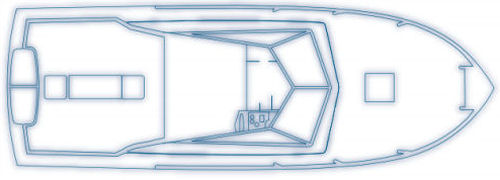
Essential Equipment.
While Carolina Classic doesn’t offer a long list of bells and whistles, if it’s important for fishing it’s probably there -- like standard-equipment seawater and freshwater washdown spigots in the cockpit. Equipment that’s nice to have when far offshore is also standard, such as two bilge pumps plus a high bilge-water alarm and Racor water-separating fuel filters. Twin windshield wipers (many boats just put one in front of the skipper) keep two sets of eyes ahead on those days the fish are far away and straight into a stiff breeze.
Customization.
Because they build one boat at a time, Carolina Classic can tweak hardware for buyers’ requests, too. Need lots of gunwale-mounted rod holders and four downrigger power plugs for Great Lakes trolling? No problem. Prefer to have no gunwale rod holders but want a cockpit rocket launcher for kite fishing off Miami? Done.
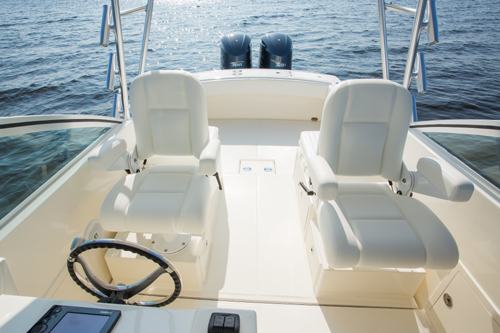
Big-Boat Features with Small-Boat Convenience
Small boats have their advantages. It’s just a few steps from the helm to the cockpit, for instance, so the captain can help set the spread or handle double or triple hookups, but also get back to the helm in an instant when needed. Try that from the flying bridge of a 54-footer.
What boats in this size range often lack are features dedicated to fishing -- for example, lots of fishbox space and a generous tackle center, come to mind. Either or both are available on the Carolina Classic. Five quick-access tackle drawers are just one of many options for the space beneath seats just behind the helm (located where the captain can help with tackle).
Other options
here include cabinets built to hold clear plastic tackle storage trays, or insulated drink coolers aft with storage forward, or 43'' long insulated fishboxes (for a possible total of three large fishboxes aboard), or ordinary storage cabinets without drawers.
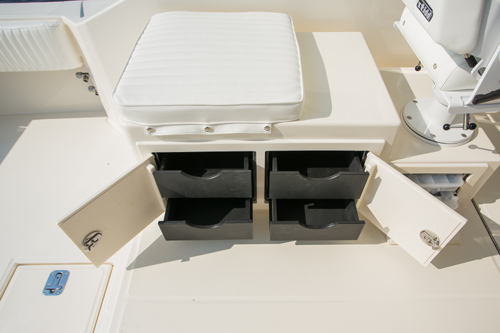
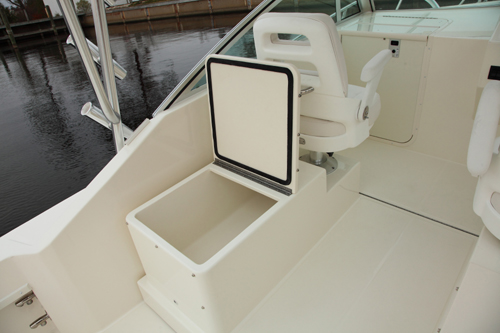
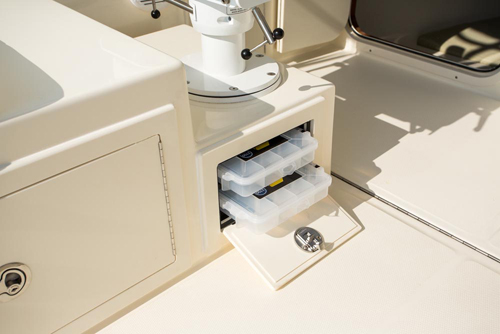
At the Helm
The dash on this 25-footer, just below eye level, is about as large as is normally seen on a 35 footer. It has enough real estate for two large electronics displays and more to spare. Carolina Classic includes a compass at the top -- right where it needs to be to hold a course offshore or when entering a tricky inlet. On the horizontal surface just forward of the stainless steering wheel (the wheel has a speed steering knob, by the way), there is a row of weatherproof switches plus room for an autopilot and other gear.
The vertical surfaces on either side of the steering wheel offer more space to hang more electronics. The entire helm pod is hinged at the bottom to allow easy access to the inside for mounting all that equipment. Padded captain and companion chairs swivel and adjust. Opening windshield vents bring in fresh air, even when spray keeps isinglass closed.
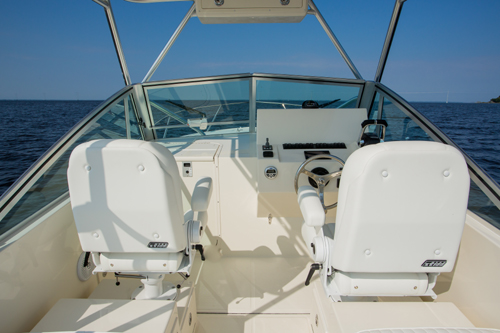
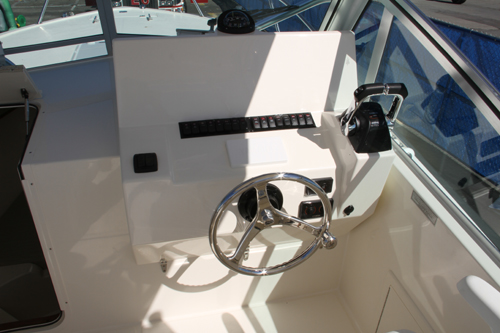
Topping it Off
The boat we reviewed has a fiberglass and aluminum hardtop with welded aluminum rod holders on the hardtop legs, cockpit flood lights mounted in the hardtop rail, and Lee Sidewinder outriggers attached directly to aluminum, not just bolted through the top. The top is completely customizable, from ordinary hardtop to crow’s nest steering station to a mini tower. Add welded rod holders across the back of the hard top, if you’d like, or just about anything that can be imagined and welded from aluminum.
Foredeck
Ample side decks and stout railings access the bow, where a bow locker has chocks to hold a Danforth-type anchor. The bow has cleats, chocks, running lights and a hatch for the cabin, of course, but little more -- it’s the intentionally uncluttered bow of a fishboat.
Below Deck
The cuddy cabin is equally straightforward -- a V-berth with filler cushion, shelves outboard, rod storage overhead, and a hanging locker. But Carolina Classic designers think like offshore fishermen. Before nearly every fishing trip, the V-berth collects duffle bags full of foul weather gear, dry clothes and extra tackle, which is then thoroughly shuffled on the ride out.
Clever Potti.
On most boats, finding your foulies or that perfect lure means sorting through a pile of stuff while crawling atop the Porta-Potti, since most builders put the toilet in the notch at the center of the V-berth. Carolina Classic instead incorporates an electric head farther aft, on a door that swings it out for use but otherwise keeps the toilet out of sight. That clears the notch at the center of the V-berth for better access. And when the V-berth is used for sleeping, anglers won’t be resting their heads directly above the toilet.
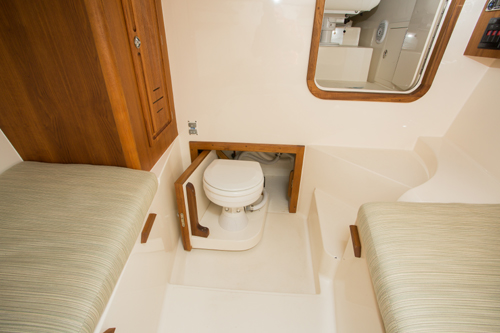
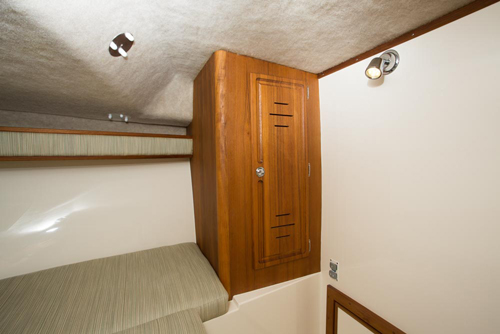
Performance and Range
We have not tested the boat. But the folks at Carolina Classic have. They have told us that with a pair of 4.2 L, 250-hp 4-stroke V-6 Yamaha outboards, there is a "sweet spot" between 31 mph and 38 mph cruising speed. At 34 mph they claim 1.7 miles per gallon for a 229-mile range from 215 gallons of fuel, assuming a 10% fuel reserve.
Propulsion options currently include twin 200-, 250- or 300-hp outboards, in addition to the long-standing choices of single inboard gas or diesel connected to a sterndrive or conventional shaft.
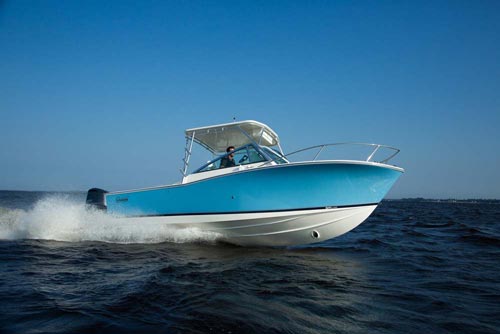
Effects of Weight.
All things being equal -- this Carolina Classic 25 outer hull is identical in all engine configurations -- having the weight of outboards aft tends to make a boat rise and fall a little softer at high speed over moderate seas. But when Mother Nature dictates slowing down, the weight of inboards forward tends to make a slog into head seas a bit more comfortable. The builder reports roughly those results from this boat when comparing varying power options.
Propulsion Comparisons
Carolina Classic reports that the outboard-powered boat stays fully on plane at a similar running angle from cruise all the way down to 16 knots, while the same hull with inboards maintains a steady running angle just a bit longer, down to 14 knots before dropping her stern and raising her bow. But the outboard-powered version gets a bonus. Carolina Classic adds larger trim tabs -- 12'' wide by 14'' long. Trimming both outboards and tabs allows better control of running attitude to suit conditions. And while long, skinny trim tabs are generally a liability on fishing boats, the Armstrong bracket mitigates line-snagging concerns here.
It’s All About Fishability
Another Difference.
There is another often-overlooked difference between inboard and outboard boats -- when drifting while fishing, the outboard or sterndrive versions of this Carolina Classic drifts more or less quartering the sea, while drag from the inboard’s prop, shaft and rudder keeps the boat a bit more beam-to. It’s a minor consideration based on how an angler fishes: Live bait fishermen might prefer baits a bit more off the stern with outboards, while those drifting for swordfish would rather lay with the wind closer to abeam with the conventional shaft, prop and rudder.
But what impressed me was that Carolina Classic naval architects considered how the boat would drift as one of the factors when contemplating outboard power for a longtime-favorite model. That focus on fishing, right down to the way the outriggers and gunwale rod holders are installed, is what separates this Carolina Classic 25 from so many similarly sized boats.

